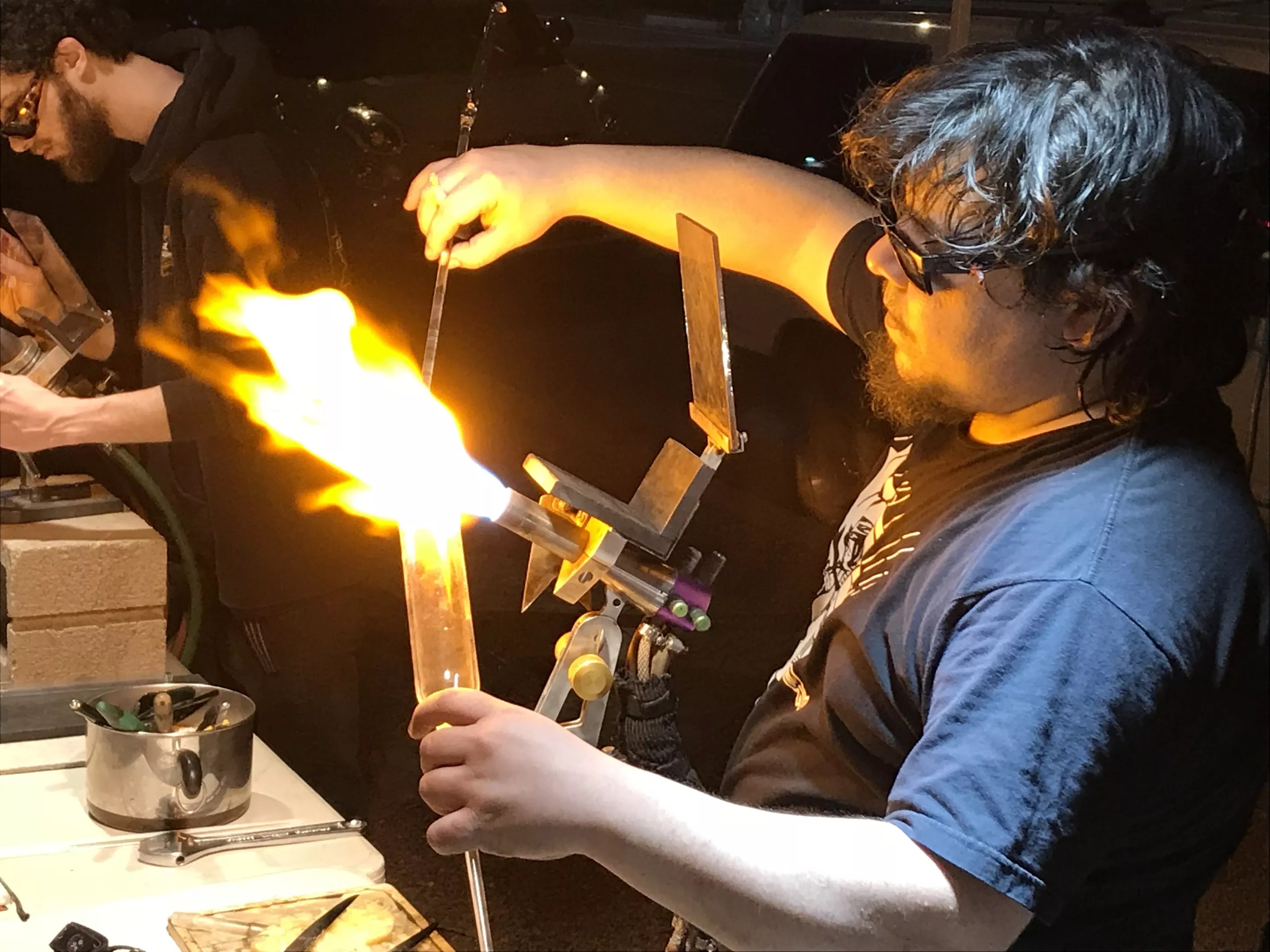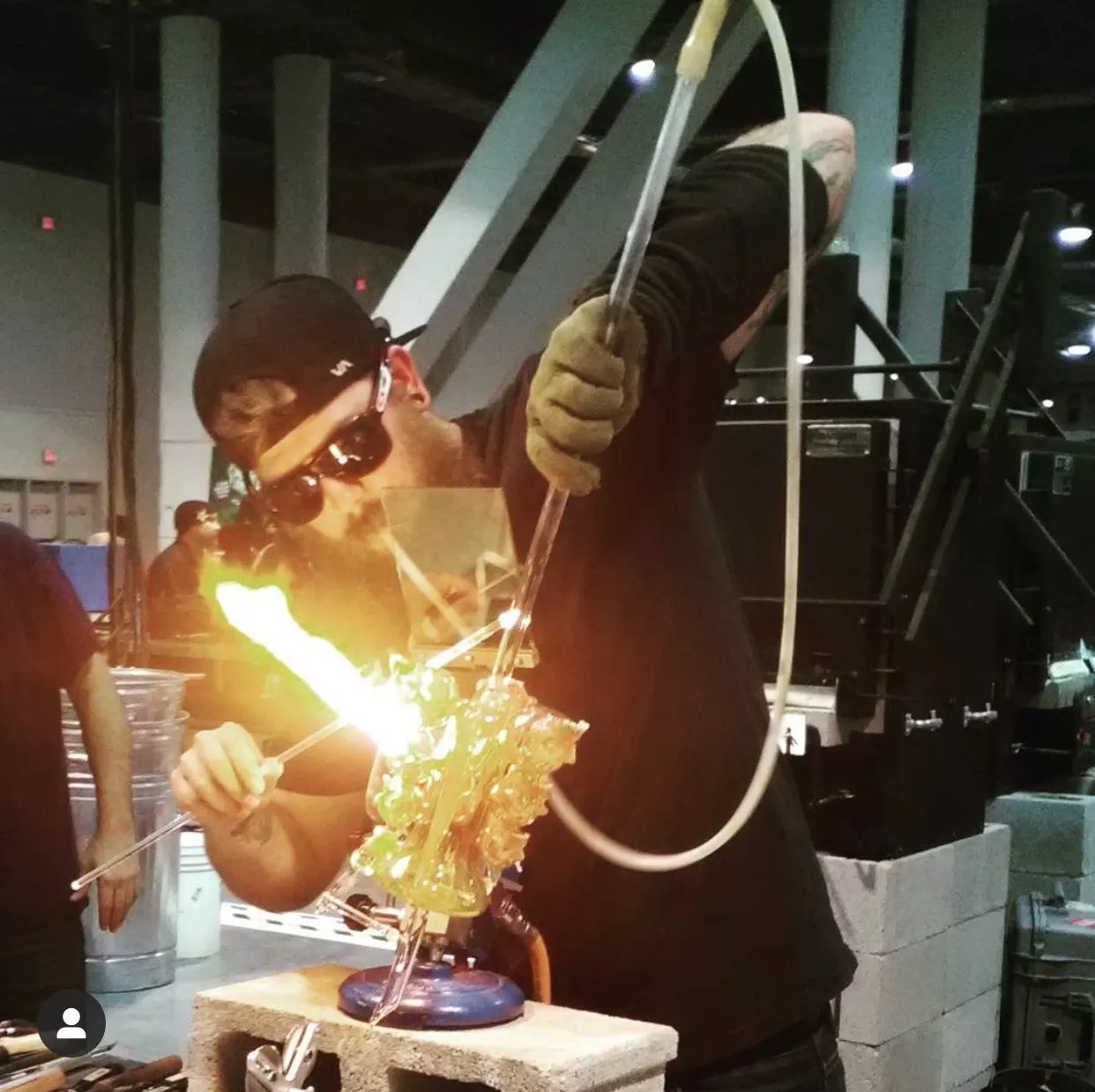
Lynn Trimble

Audio By Carbonatix
A pair of artists wielding glass tubes and torches often sit outside Bud’s Glass on Grand Avenue during First Friday art walks, doing demonstrations for people making the rounds at the galleries. Though fascinated by the fire, many fail to realize they’re watching artists in action – in part because the small sculptural pieces also serve as pipes for smoking tobacco, marijuana, or other herbal concoctions.
Making bongs and other types of pipes is a mainstay of many glass artists’ careers, says Greg Centrone, who launched Bud’s Glass Joint in Roosevelt Row with business partner Andrew Meister in 2012, then added the Grand Avenue location in 2019. (Meister and his wife, Jennifer, both work at Phoenix New Times.)
“For a lot of these artists, making pipes is how they make a living, just because the pipes are so popular,” says Centrone. “Some of them kind of find their artistic outlet after they get into it for the money.”

Bongs made for Arizona-based Glowfly Glass.
Glowfly Glass
Centrone recalls getting his first glass pipe as a teenager but admits he didn’t appreciate the artistic properties until he learned more about how glass pipes get made. “It takes a lot of shaping, like sculptural work, and the artists have to know how to work with color,” he says. Most glass pipes are made with borosilicate glass, which is less likely to crack at high temperatures. Glass blowers use flames and assorted tools to shape clear glass tubes, using color rods to help create their unique designs.
Glass art of this kind is rooted, of course, in the counterculture of the late ’60s and ’70s. But the craft has become more mainstream in recent years, as legalization has further normalized marijuana use. Now, some people collect glass pipes even if they never smoke out of them. Last year, the Corning Museum of Glass in New York acquired a contemporary glass pipe by Massachusetts artist David Colton. Its flowing bright pink lines channel graffiti, another art form that’s made the transition from underground to mainstream in recent years.
Kemp Curtis, a Georgia artist who got his start blowing glass for Disneyland and went on to build an international following making pipes, says acquisitions like these are evidence that the art world is finally recognizing the aesthetic properties of glass pipes.
Even so, not every bong is a work of art.
“There’s a mechanical and technical side to making glass art,” says Curtis. “There’s also an aesthetic side, which has a lot to do with color.” As equipment like torches and kilns have evolved, making glass pipes has become more sophisticated. Still, he says, there’s a mass market fueled largely by Chinese imports designed to meet demand for cheap products rather than artistic vision.
“Ultimately, art is in the eye of the beholder,” says Bisbee glass artist Rich Creek, who counts Curtis as one of his creative inspirations. He notes that there are several books and videos about whether glass pipes are art, including Degenerate Art: The Art and Culture of Glass Pipes, a 2011 documentary.

Shawn “Hendy” Henderson working in his Chandler studio.
Shawn Henderson
Here in metro Phoenix, the best-known artists include Shawn “Hendy” Henderson of Chandler, who works full time in his studio making glass pipes. Like a lot of glass artists, he fell into the field by happenstance.
“I was really athletic in high school, and I never pictured myself being artistic,” he recalls. Henderson was working in an aquatics shop the day he met a glassblower who was looking for an apprentice. At first, Henderson made small fish and coral figures. Now, he makes elaborate pipes that sell for several thousand dollars.
“I’ve evolved over time like anybody does, becoming more stylistic,” Henderson says. “Once I started understanding what I could do and feeling like I had a relationship to the glass, I became more of an alchemist and started doing more carves and cuts that would have terrified me before.”
His first chandelier, made with tiers of purple glass, hangs inside Bud’s on Grand. It’s a nod to Henderson’s dreams of making more than glass pipes.

One of Shawn Henderson’s figurative glass works.
Shawn Henderson
“We all want to cross over into fine art,” he says. But making the transition isn’t easy – in part, he says because galleries he’s approached have recoiled when they’ve learned that his body of work includes glass pipes.
Centrone wants to help change that, in part by showcasing Arizona glass artists whose practice includes making pipes. “I’m trying to break the stigma so people won’t be afraid of a piece of art because someone might smoke cannabis out if it,” he says. “People shouldn’t think a work of art is less beautiful because they associate it with cannabis culture.”